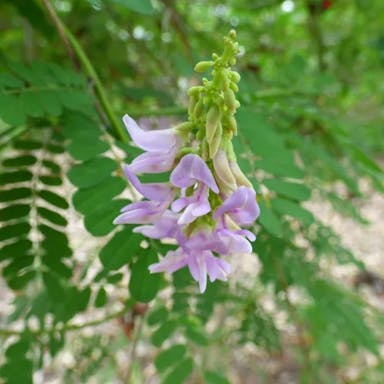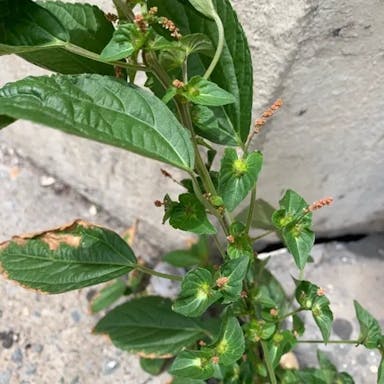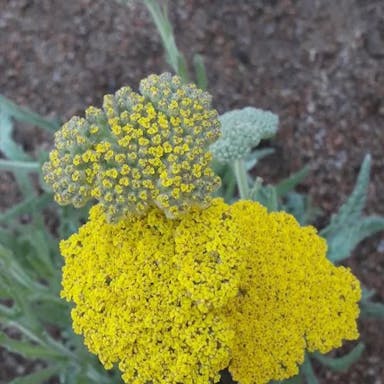Capsicum pubescens, commonly known as Apple chile, is a plant species that belongs to the Solanaceae family. It is native to South America, particularly Peru and Bolivia. This evergreen likes well-drained soil and ample sunshine. The flowers have a distinctive shape with petals. The round fruit changes color as it ripens, with hues of green, yellow, orange or red. This plant has a spicy, fruity taste used in traditional cuisine. It can live for years with proper care and is resistant to common garden problems. In all, a unique plant with versatile uses.
Apple chile
- Scientific name
- Capsicum pubescens
Basic Information
- Solanaceae Family Capsicum Genus Apple chile Species
- Solanaceae > Capsicum > Capsicum pubescens
- 83%
- The Completeness of This Encyclopedia
Please help us complete the encyclopedia, Terrarium is a encyclopedia service to be completed with everyone in the world. Currently, this page is 83% complete. For more information on how to contribute, please click here.
- Forb/herb
- Fruit
- Perennial
- Vegetable
- Height
- 130cm ~
- Flower Color
- Leaf Color
- Anthesis
- summer
- Sunlight Exposure
Full Sun Long hours of sunlight from morning to afternoon Partial Shade A location in the shade of a tree or where either the morning or afternoon is shaded Full Shade A place where there is no direct sunlight
- Full Sun
- Hardiness Zones
This is an indicator to know to which zone each plant can winter. Knowing the zone of each plant gives you an idea of the cold temperature resistance when grown in the ground without a roof. 2: -42.7 to -40.0 3: -39.9 to -34.4 4: -34.3 to -28.9 5: -28.8 to -23.3 6: -23.2 to -17.8 7: -17.7 to -12.2 8: -12.1 to -6.7 9: -6.6 to -1.1 10: -1.0 to 4.4 11: 4.5 to 10.0
- 10
- Cold resistance
- Poor
- Heat resistance
- Excellent
- Habitat of origin
- Bolivia, Peru
- Growth Rate
- Normal
What is Apple chile (Capsicum pubescens)?
What is Apple chile (Capsicum pubescens)
Flower meaning
The plant needs tropical climates. It produces pleasant smells. Leaf cuttings propagate it. The perennial endures ten years. The tree reaches nine meters tall. It bears purple flowers. The bark treats fever.
Calendar of Apple chile (Capsicum pubescens)
Calendar
Apple chile, scientifically known as Capsicum pubescens, is a perennial plant that belongs to the Solanaceae family. It is native to South America. The blooming time of Apple chile typically occurs during the summer months, specifically from June to August. The flowers of Apple chile are usually white or pale green. To ensure blooming, provide sunlight and nutrients. Additionally, avoid excessive pruning during this time. For more details, consult experts. Leafy greens require full sun and moist, nutrient-rich soil. They are prone to pests like aphids. Row covers prevent insect damage. Harvest greens when young and tender. Eat raw in salads or lightly cooked. Popular varieties are oakleaf, red sail, green and red romaine. Lettuce can be grown in containers. Space or thin seedlings 8-12 inches apart. Sow seeds 1⁄4 inch deep. Water deeply and allow soil to partially dry between waterings. Fertilize every 2-3 weeks. Rotate planting location yearly to prevent disease.
How to grow Apple chile (Capsicum pubescens)
Watering
Apple chile, a plant commonly known as Capsicum pubescens, requires a specific watering regimen to thrive. Every two to three days is the optimal frequency of watering during the growing season, which typically occurs in the spring and summer months. This ensures that the soil remains consistently moist but not waterlogged. It is important to note that the amount of water needed may vary depending on factors such as temperature and humidity. As a general guideline, providing approximately 1 inch of water per week is recommended. However, it is crucial to monitor the soil moisture levels regularly to avoid overwatering or underwatering. The watering frequency should be reduced to once every seven to ten days during the dormant season, which usually takes place in the fall and winter. This allows the plant to enter a period of rest and prevents excessive moisture retention in the soil. Overall, maintaining proper soil humidity and adhering to the recommended watering frequency will contribute to the healthy growth.
Soil and Fertilizer
Apple chile, scientifically known as Capsicum pubescens, is a plant that belongs to the Solanaceae family. It is native to South America and is commonly grown for its edible fruits. When it comes to soil conditions, always Apple chile requires well-drained soil that is slightly acidic, but not too acidic. The soil should allow water to drain but also retain some moisture. It is important that the soil not become waterlogged or too compact, as this causes problems for the roots and stops the plant from growing properly. With regard to providing nutrients, Apple chile needs balanced amounts of the main elements that plants require - nitrogen, phosphorus and potassium. A fertilizer ratio of 10-10-10 would be suitable. This complete fertilizer should be given to the plant when first planted and then every 4 to 6 weeks over the growing season. How much fertilizer to apply depends on the soil's quality and nutrients, so it's best to test the soil and follow recommendations from agricultural experts about the right amounts for that soil type and the needs of Apple chile. In summary, Apple chile grows best in soil that drains well but retains moisture, with a pH that is moderately acidic. It requires fertilizer with nitrogen, phosphorus and potassium, like a 10-10-10 ratio, added when planted and regularly during the growing months. The exact amounts to use depend on soil testing results and recommendations for that specific soil and plant.
Sunlight and Place
Apple chile plant need full unshadow to bloom well. Suitable cold weather regions. However hot struggle. Temperature range Apple chile sixty seventy-five Fahrenheit fifteen Celsius. Summer water enough drain wet prevent. Winter frost but maybe guard severe frigid. Put Apple chile straight sunshine least six hour every day. Thrive full sun maybe not well shadow. Sun need change little kind variety.
Advanced Information of Apple chile (Capsicum pubescens)
Pruning
Apple chile, a delicious fruit plant, requires routine pruning. Pruning removes lifeless branches, aids airflow, promotes growth. Seasons for Apple chile pruning are late winter or early spring. Pruning starts by eliminating any dead or damaged branches. Branches crossing or touching are thinned. Cuts are above a bud or side branch. Avoid stubs as disease or decay happens. After pruning, a balanced fertilizer is good. Annual pruning maintains plant shape. Use clean, sharp tools to stop disease spreading. Pruning helps looks and fruit making of Apple chile.
Planting and Harvest
Apple chile, also known as Capsicum pubescens, is a plant that can be potted or planted in the ground. For potted planting, choose suitable container with good drainage and fill it with well-draining soil rich in nutrients. Place the vegetable in the pot, ensuring that the roots are covered with soil. Water the vegetable thoroughly and place it in a spot with ample sunlight and ventilation. At regular intervals, let the soil dry slightly before watering. Administer organic fertilizer for growth every 10-14 days. When overgrown, the vegetable can be moved into a slightly bigger pot with fresh soil. Pruning of dead leaves and branches helps the vegetable grow new leaves and branches. Apple chile is a multipurpose vegetable that can thrive in indoor gardens and open soil, as long as it receives proper maintenance.
Propagation
Apple chile can be propagated through various methods such as sowing seeds, division, cuttings, and leaf cuttings. To propagate through sowing seeds, collect ripe fruits and extract the seeds. Clean the seeds and sow them in a well-draining potting mix. Keep the soil moist and provide indirect sunlight. For division, carefully separate the plant into smaller sections, ensuring each section has roots and shoots. Plant the divisions in separate containers with well-draining soil and water regularly. To propagate through cuttings, take stem cuttings from healthy plants and remove the lower leaves. Dip the cut end in rooting hormone and plant it in a pot with moist soil. Place the pot in a warm and humid environment. Leaf cuttings can also be used for propagation. Take a healthy leaf and cut it into sections. Plant the sections in a pot with well-draining soil and keep the soil moist. Harvesting is not applicable for propagation methods. It is the process of collecting mature crops from the fields for sale or storage. Propagation refers to reproducing and multiplying the plant population.
Pests and Diseases
Apple chile, also known as Capsicum pubescens, is susceptible to various pests and diseases. Correctly sing in funnel for the reading. Another disease is bacterial spot, which passages dark spots on the leaves and fruit, leading to reduced quality and yield. To prevent these pests and diseases, it is central to maintain practiced crop rotating and avoiding sank susceptible crops in the same style. Additionally, practicing crop rotation and avoiding planting susceptible crops in the same equal can helping prevent the buildup of pests and diseases in the stain. The withering of Apple chile plants can be focused by varied factors, including illegal watering, nutrient deficiencies, external temperatures, or snow diseases. It is substantial to provide the raised with sufficient watering, especially during wispy periods, and ensure proper drainage to prevent waterlogging. Regularly fertilizing the check with balanced nutrients can help prevent nutria deficiencies. Protecting the flora from invert temperatures, such as providing fall during hot summer sun or using frost protection during cold periods, can also help prevent withering. If snow diseases are suspected, it is advisable to inspect the roots for any signs of rot or damage and catch appropriate measures, such as applying fungicides or improving soil waterproof.
Habitat of Apple chile (Capsicum pubescens)
Habitat
Toxicity of Apple chile (Capsicum pubescens)
Health Benefits
- edible
- edible
- Toxic
- No toxicity
NO DATA
Toxic for dogs and cats
NO DATA
Q&A of Apple chile (Capsicum pubescens)
- Is there a recommended way to choose Apple chile?
Apple chile, also known as Capsicum pubescens, is a unique variety of chili pepper that is native to South America. The characteristics and preferences of each variety need considering when choosing varieties of Apple chile. A well-liked variety is the Rocoto Apple chile, famous for its big, round fruits and thick flesh. It has a medium to hot level of spiciness and is regularly used in traditional Peruvian food. Another variety is the Manzano Apple chile, notable for its apple shape and crisp texture. It has a mild to medium level of spiciness and is generally used in salsas and sauces. When buying Apple chile seeds, it's suggested to opt for seeds from good suppliers specializing in chili peppers. Seeds that are fresh and have high germination rates are best. It's also key to think about the precise growing conditions Apple chile needs, like temperature and sunlight preferences. If buying Apple chile seedlings, choose healthy plants with robust stems and colorful leaves. Avoid diseased or pest damaged plants. Transplant the seedlings into well-draining soil and give adequate water and sunlight for successful growth. Overall, picking the appropriate variety, seeds, or seedlings of Apple chile is vital for a good gardening experience.
0
0











